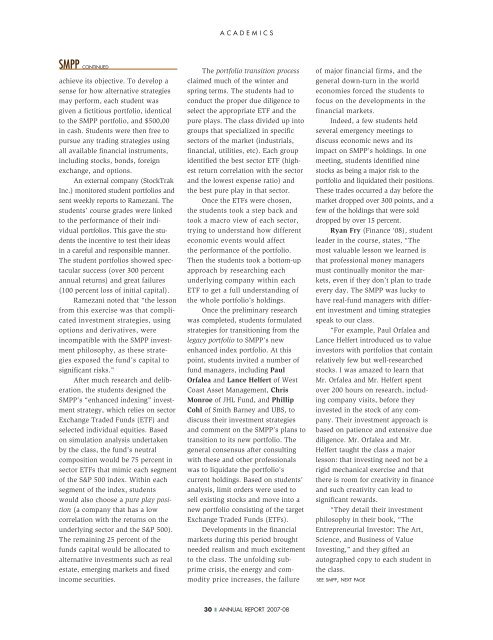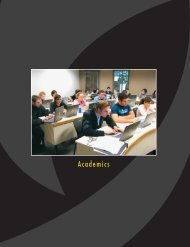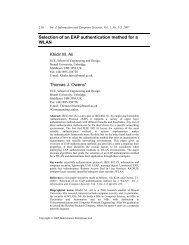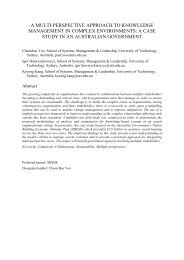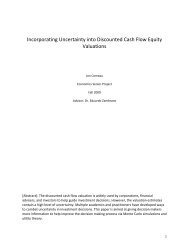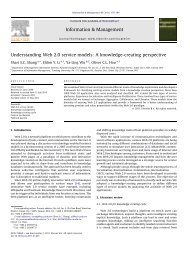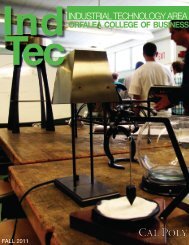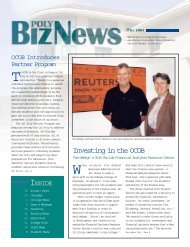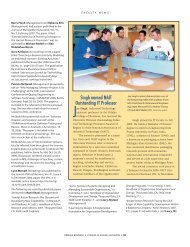OCOB Ann Rep 07-08 - Orfalea College of Business - Cal Poly San ...
OCOB Ann Rep 07-08 - Orfalea College of Business - Cal Poly San ...
OCOB Ann Rep 07-08 - Orfalea College of Business - Cal Poly San ...
You also want an ePaper? Increase the reach of your titles
YUMPU automatically turns print PDFs into web optimized ePapers that Google loves.
ACADEMICSSMPP CONTINUEDachieve its objective. To develop asense for how alternative strategiesmay perform, each student wasgiven a fictitious portfolio, identicalto the SMPP portfolio, and $500,00in cash. Students were then free topursue any trading strategies usingall available financial instruments,including stocks, bonds, foreignexchange, and options.An external company (StockTrakInc.) monitored student portfolios andsent weekly reports to Ramezani. Thestudents’ course grades were linkedto the performance <strong>of</strong> their individualportfolios. This gave the studentsthe incentive to test their ideasin a careful and responsible manner.The student portfolios showed spectacularsuccess (over 300 percentannual returns) and great failures(100 percent loss <strong>of</strong> initial capital).Ramezani noted that “the lessonfrom this exercise was that complicatedinvestment strategies, usingoptions and derivatives, wereincompatible with the SMPP investmentphilosophy, as these strategiesexposed the fund’s capital tosignificant risks.”After much research and deliberation,the students designed theSMPP’s “enhanced indexing” investmentstrategy, which relies on sectorExchange Traded Funds (ETF) andselected individual equities. Basedon simulation analysis undertakenby the class, the fund’s neutralcomposition would be 75 percent insector ETFs that mimic each segment<strong>of</strong> the S&P 500 index. Within eachsegment <strong>of</strong> the index, studentswould also choose a pure play position(a company that has a lowcorrelation with the returns on theunderlying sector and the S&P 500).The remaining 25 percent <strong>of</strong> thefunds capital would be allocated toalternative investments such as realestate, emerging markets and fixedincome securities.The portfolio transition processclaimed much <strong>of</strong> the winter andspring terms. The students had toconduct the proper due diligence toselect the appropriate ETF and thepure plays. The class divided up intogroups that specialized in specificsectors <strong>of</strong> the market (industrials,financial, utilities, etc). Each groupidentified the best sector ETF (highestreturn correlation with the sectorand the lowest expense ratio) andthe best pure play in that sector.Once the ETFs were chosen,the students took a step back andtook a macro view <strong>of</strong> each sector,trying to understand how differenteconomic events would affectthe performance <strong>of</strong> the portfolio.Then the students took a bottom-upapproach by researching eachunderlying company within eachETF to get a full understanding <strong>of</strong>the whole portfolio’s holdings.Once the preliminary researchwas completed, students formulatedstrategies for transitioning from thelegacy portfolio to SMPP’s newenhanced index portfolio. At thispoint, students invited a number <strong>of</strong>fund managers, including Paul<strong>Orfalea</strong> and Lance Helfert <strong>of</strong> WestCoast Asset Management, ChrisMonroe <strong>of</strong> JHL Fund, and PhillipCohl <strong>of</strong> Smith Barney and UBS, todiscuss their investment strategiesand comment on the SMPP’s plans totransition to its new portfolio. Thegeneral consensus after consultingwith these and other pr<strong>of</strong>essionalswas to liquidate the portfolio'scurrent holdings. Based on students'analysis, limit orders were used tosell existing stocks and move into anew portfolio consisting <strong>of</strong> the targetExchange Traded Funds (ETFs).Developments in the financialmarkets during this period broughtneeded realism and much excitementto the class. The unfolding subprimecrisis, the energy and commodityprice increases, the failure<strong>of</strong> major financial firms, and thegeneral down-turn in the worldeconomies forced the students t<strong>of</strong>ocus on the developments in thefinancial markets.Indeed, a few students heldseveral emergency meetings todiscuss economic news and itsimpact on SMPP’s holdings. In onemeeting, students identified ninestocks as being a major risk to theportfolio and liquidated their positions.These trades occurred a day before themarket dropped over 300 points, and afew <strong>of</strong> the holdings that were solddropped by over 15 percent.Ryan Fry (Finance ‘<strong>08</strong>), studentleader in the course, states, “Themost valuable lesson we learned isthat pr<strong>of</strong>essional money managersmust continually monitor the markets,even if they don’t plan to tradeevery day. The SMPP was lucky tohave real-fund managers with differentinvestment and timing strategiesspeak to our class.“For example, Paul <strong>Orfalea</strong> andLance Helfert introduced us to valueinvestors with portfolios that containrelatively few but well-researchedstocks. I was amazed to learn thatMr. <strong>Orfalea</strong> and Mr. Helfert spentover 200 hours on research, includingcompany visits, before theyinvested in the stock <strong>of</strong> any company.Their investment approach isbased on patience and extensive duediligence. Mr. <strong>Orfalea</strong> and Mr.Helfert taught the class a majorlesson: that investing need not be arigid mechanical exercise and thatthere is room for creativity in financeand such creativity can lead tosignificant rewards.“They detail their investmentphilosophy in their book, “TheEntrepreneurial Investor: The Art,Science, and <strong>Business</strong> <strong>of</strong> ValueInvesting,” and they gifted anautographed copy to each student inthe class.SEE SMPP, NEXT PAGE30 ❚ ANNUAL REPORT 20<strong>07</strong>-<strong>08</strong>


